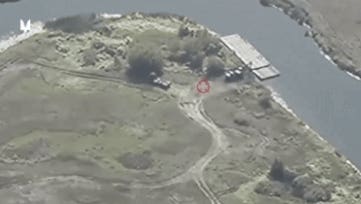Determined to isolate the 300 square miles of Russia’s Kursk Oblast southwest of the Seym River, the Ukrainian army and air force struck—in a heady four days starting on Friday—all three permanent bridges across the Seym River in Russia’s Kursk Oblast.
Russian engineers mobilized—rushing sections of floating pontoon bridges to the Seym and launching boats to piece the sections together. But the Ukrainians expected this move. They launched explosive first-person-view drones to intercept the engineers’ convoys—and fired rockets to blow up the boats and pontoons on the water.
The effect, six days into the river campaign, is that a huge swathe of Kursk—and any Russian troops there—is effectively cut off from overland supplies and reinforcements. And don’t expect large-scale aerial resupply: Ukrainian forces have made the air over Kursk extremely inhospitable to Russian helicopters.
That the Ukrainians are so determined to isolate Kursk Oblast left of the Seym is a strong signal that their next move, 15 days into their invasion of Kursk, might be a ground attack across the Seym into the same region they just isolated.
The first hints Ukraine was targeting bridges in Kursk came on Friday, when imagery appeared online depicting worsening damage—the result of back-to-back strikes—to a concrete span across the Seym in Glushkovo, nine miles west of the front line of the 500-square-mile invasion zone.
The bridge raids marched westward over the next three days. Through Monday, rockets and bombs hit concrete spans in Zvannoe and Karyzh—badly damaging or destroying each. With the raid on the bridge in Karyzh on Monday, the Russians no longer had any easy way of getting vehicles into Kursk Oblast southwest of the Seym.
So they deployed engineering units with pontoons and boats. Scrutinizing satellite imagery, Radio Free Europe correspondent Mark Krutov identified the construction of at least three pontoon bridges.
But if Krutov could see the floating bridges, Ukrainian intelligence could see them, too. Ukrainian FPV drones intercepted some of the bridging units while they were still on the road. Drones pinpointed other units as they were craning or floating the pontoon sections into place.
Perhaps most dramatically, M30/31 rockets fired by the Ukrainian army’s U.S.-made High Mobility Artillery Rocket System peppered one of the pontoons with hundreds of grenade-sized bomblets.
The attacks continued into Monday, with Ukrainian forces “striking pontoon bridges and engineering equipment in the western part of their operational zone in the Glushkovo district,” the Ukrainian Center for Defense Strategies reported.
Ukrainian troops aim to “outpace the enemy in the operational deployment of forces in this direction,” according to CDS. The destruction of bridges is the key. The Russians no longer have any easy way into that part of Kursk, but the Ukrainians can enter the area by crossing the border.
Given a safer air-defense environment, the Russians might just resupply and reinforce their troops between the Seym and the border with helicopters. But the Ukrainians have effectively cleared the air over Kursk.
Firing surface-to-air missiles and deploying FPV drones as aerial rams, Ukrainian forces have downed several Russian helicopters in Kursk since the invasion kicked off on Aug. 6.
Sources:
1. Mark Krutov: https://www.google.com/maps/d/viewer?mid=1ZD-YrVB91qrF3EaagUOs7ur6Byj7YfE&femb=1&ll=51.38643056229995%2C34.679968218880035&z=13
2. Deep State: https://deepstatemap.live/#10/51.3198845/34.6852112
3. Center for Defense Strategies: https://cdsdailybrief.substack.com/p/russias-war-on-ukraine-210824
Read the full article here





